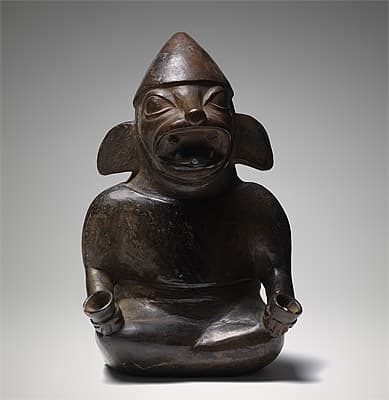
MOCHE culture North coast 100 – 800 AD
Stirrup vessel in the form of a fox c. 350 AD ceramic , mould made, blackware, smudge-fired24.8 (h) x 16.0 (w) x 21.0 (d) cm National Gallery of Australia, Canberra NGA 1983.294 Purchased 1983
Iconographic images of foxes appear on many pieces of Moche pottery and other decorated objects and, like deer, they can often be found in fine-line drawings of hunting scenes. The creatures are also depicted in fox-human forms. Several fox-shaped headdresses have been discovered, and can be readily identified on the portrait head pots of the Moche (see cats 93–97).
Foxes were venerated for their wiliness and hunting abilities. Common in the highland areas where they were hunted for their fur, they also populated the coastal areas of Peru. The Sechuran fox (Lycalopex sechurae) is found in the northern Moche territory—it is a slightly smaller species than the Andean or South American fox, which lives in the highland region.1
The Moche often depicted foxes in human form, in mould-made pots such as this. The anthropomorphised animal wears human adornment. Here, the fox sports a Moche warrior’s pointed helmet with a chin strap below his open snarling jaws. The outline of his loincloth and unku (tunic) are also visible. The figure holds a cup-like spout in each hand, so it is most likely a ceremonial vessel. The fox was a common guise for shamans and important figures. The Moche typically depict the creature with its ears back and tongue pointing out. In some cases their whiskers are prominent and, when shown on coloured pots, their two-tone tails stick straight out or curve upwards (but never down).2 These features are often not obvious when the image is anthropomorphised: here, the simple black colouring and loincloth hide all evidence of the tail.
Simeran Maxwell
1. Elizabeth P. Benson, Birds and beasts of ancient Latin America, Gainesville: University Press of Florida 1997, pp. 36, 38.
2. Christopher B. Donnan, Moche art and iconography, Los Angeles: UCLA Latin American Center Publications 1976, p. 29.
Iconographic images of foxes appear on many pieces of Moche pottery and other decorated objects and, like deer, they can often be found in fine-line drawings of hunting scenes. The creatures are also depicted in fox-human forms. Several fox-shaped headdresses have been discovered, and can be readily identified on the portrait head pots of the Moche (see cats 93–97).
Foxes were venerated for their wiliness and hunting abilities. Common in the highland areas where they were hunted for their fur, they also populated the coastal areas of Peru. The Sechuran fox (Lycalopex sechurae) is found in the northern Moche territory—it is a slightly smaller species than the Andean or South American fox, which lives in the highland region.1
The Moche often depicted foxes in human form, in mould-made pots such as this. The anthropomorphised animal wears human adornment. Here, the fox sports a Moche warrior’s pointed helmet with a chin strap below his open snarling jaws. The outline of his loincloth and unku (tunic) are also visible. The figure holds a cup-like spout in each hand, so it is most likely a ceremonial vessel. The fox was a common guise for shamans and important figures. The Moche typically depict the creature with its ears back and tongue pointing out. In some cases their whiskers are prominent and, when shown on coloured pots, their two-tone tails stick straight out or curve upwards (but never down).2 These features are often not obvious when the image is anthropomorphised: here, the simple black colouring and loincloth hide all evidence of the tail.
Simeran Maxwell
1. Elizabeth P. Benson, Birds and beasts of ancient Latin America, Gainesville: University Press of Florida 1997, pp. 36, 38.
2. Christopher B. Donnan, Moche art and iconography, Los Angeles: UCLA Latin American Center Publications 1976, p. 29.
Iconographic images of foxes appear on many pieces of Moche pottery and other decorated objects and, like deer, they can often be found in fine-line drawings of hunting scenes. The creatures are also depicted in fox-human forms. Several fox-shaped headdresses have been discovered, and can be readily identified on the portrait head pots of the Moche (see cats 93–97).
Foxes were venerated for their wiliness and hunting abilities. Common in the highland areas where they were hunted for their fur, they also populated the coastal areas of Peru. The Sechuran fox (Lycalopex sechurae) is found in the northern Moche territory—it is a slightly smaller species than the Andean or South American fox, which lives in the highland region.1
The Moche often depicted foxes in human form, in mould-made pots such as this. The anthropomorphised animal wears human adornment. Here, the fox sports a Moche warrior’s pointed helmet with a chin strap below his open snarling jaws. The outline of his loincloth and unku (tunic) are also visible. The figure holds a cup-like spout in each hand, so it is most likely a ceremonial vessel. The fox was a common guise for shamans and important figures. The Moche typically depict the creature with its ears back and tongue pointing out. In some cases their whiskers are prominent and, when shown on coloured pots, their two-tone tails stick straight out or curve upwards (but never down).2 These features are often not obvious when the image is anthropomorphised: here, the simple black colouring and loincloth hide all evidence of the tail.
Simeran Maxwell
1. Elizabeth P. Benson, Birds and beasts of ancient Latin America, Gainesville: University Press of Florida 1997, pp. 36, 38.
2. Christopher B. Donnan, Moche art and iconography, Los Angeles: UCLA Latin American Center Publications 1976, p. 29.

